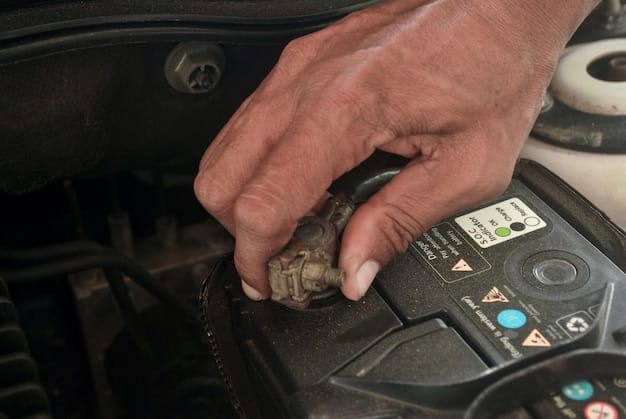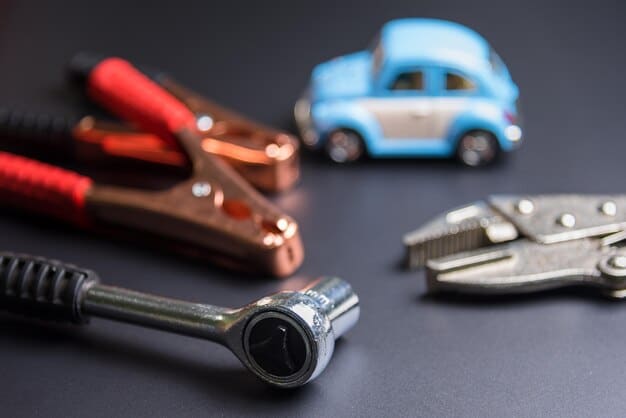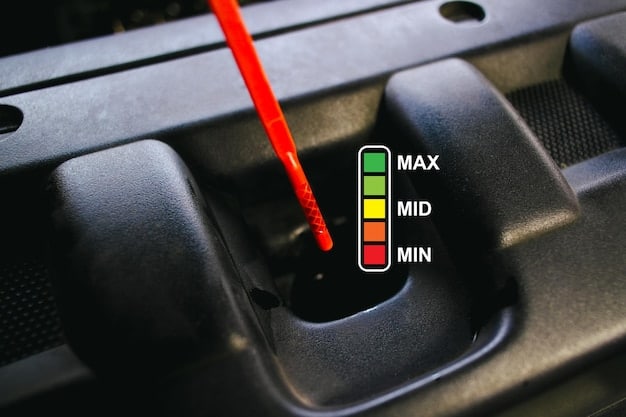Battery Maintenance 101: Prolonging Your Car Battery’s Life

Battery maintenance is crucial for extending your car battery’s life, involving regular checks, cleaning terminals, proper storage, and avoiding excessive drain to potentially add up to two years of reliable service and prevent unexpected breakdowns.
Is your car battery draining faster than usual? Battery Maintenance 101: How to Extend Your Car Battery’s Life by Up to 2 Years is simpler than you think. Learn how to keep your car running smoothly with our guide.
Understanding Your Car Battery
A car battery is the heart of your vehicle’s electrical system, providing the necessary power to start the engine and run various accessories. Understanding the basics of how your battery works can help you maintain it effectively.
Different types of car batteries exist, but the most common is the lead-acid battery. This type uses a chemical reaction to produce electricity. Over time, this reaction can lead to wear and tear, reducing the battery’s overall performance.
Types of Car Batteries
Knowing the type of battery in your car is the first step to proper maintenance. Here are the main types:
- Lead-Acid Batteries: These are the most common and affordable type, used in most standard vehicles.
- AGM (Absorbent Glass Mat) Batteries: These are more durable and resistant to vibrations, often used in vehicles with start-stop systems.
- Lithium-Ion Batteries: Found in hybrid and electric vehicles, these are lightweight and offer a long lifespan.
Regularly inspecting your battery’s condition, understanding the warning signs of a failing battery, and performing simple maintenance tasks can greatly extend its lifespan. A well-maintained battery not only saves you money but also prevents inconvenient breakdowns.
Essential Tools for Battery Maintenance
Having the right tools on hand makes battery maintenance easier and safer. Gather these essentials before you start any maintenance tasks on your car battery.
These tools will help you clean terminals, check voltage, and disconnect the battery without causing damage. Proper tools ensure you can perform maintenance safely and effectively.

Must-Have Tools
Equipping yourself with the right tools will make the maintenance process smoother and safer:
- Wire Brush: Cleans corrosion from terminals effectively.
- Battery Terminal Cleaner: Provides a deeper clean for terminals.
- Wrench Set: Necessary for loosening and tightening battery terminals.
- Voltmeter: Measures the battery’s voltage to assess its health.
Always wear safety glasses and gloves when working with a car battery. These protect your eyes and skin from battery acid. With the right tools and safety gear, you’re ready to tackle basic battery maintenance.
Cleaning Battery Terminals: A Step-by-Step Guide
Cleaning corroded battery terminals is one of the most effective ways to maintain your car battery. Corrosion can reduce the battery’s ability to deliver power and can even prevent your car from starting.
Follow this step-by-step guide to safely and thoroughly clean your battery terminals. Regular cleaning prevents corrosion buildup and ensures a solid connection.
Steps for Cleaning Terminals
Cleaning battery terminals is a straightforward process:
- Gather Your Supplies: Collect your wire brush, battery terminal cleaner, wrench, safety glasses, and gloves.
- Disconnect the Battery: Use the wrench to loosen and remove the negative (black) terminal first, followed by the positive (red) terminal.
- Clean the Terminals: Use the wire brush and battery terminal cleaner to scrub away any corrosion from both the terminals and the connectors.
- Reassemble: Reattach the positive terminal first, followed by the negative terminal. Make sure they are securely tightened.
After cleaning, apply a thin layer of dielectric grease to the terminals to prevent future corrosion. Cleaning your battery terminals every few months can significantly extend your battery’s life.
Checking Battery Voltage: Understanding the Numbers
Checking your battery’s voltage is an easy way to gauge its health. A healthy battery should have a voltage reading within a specific range. Both overcharging and undercharging can damage the battery.
Knowing how to use a voltmeter and understanding the readings can help you identify potential issues early. Early detection can save you from unexpected battery failure.

How to Check Voltage
Here’s how to check your battery’s voltage:
- Prepare Your Voltmeter: Set your voltmeter to the DC voltage setting.
- Connect the Leads: Connect the red lead to the positive terminal and the black lead to the negative terminal.
- Read the Voltage: Observe the reading on the voltmeter. A healthy battery should read around 12.6 volts when the engine is off.
If the voltage is significantly lower than 12.6 volts, your battery may be losing its charge. If the voltage is higher than 13 volts with the engine running, your alternator might be overcharging the battery. Regularly checking the voltage can help prolong your car battery’s life and prevent breakdowns.
Avoiding Common Battery Drains
One of the most common reasons for battery failure is excessive drain. Leaving lights on, using accessories while the engine is off, or having faulty electrical components can quickly drain your battery.
Being mindful of your car’s electrical usage can help prevent unnecessary battery drain. Simple changes in habits can make a big difference in battery life.
Practice Mindful Usage
Follow these simple tips to avoid unnecessary battery drain:
- Turn Off Lights: Always ensure headlights and interior lights are off when you exit your vehicle.
- Limit Accessory Use: Avoid using the radio, air conditioning, or other accessories for extended periods while the engine is off.
- Check for Faulty Components: Have your car inspected for any electrical issues that might be draining the battery.
Regularly monitoring your car’s accessories and electrical components can greatly extend the life of your battery. Avoiding these common drains helps ensure your battery stays charged and ready.
Proper Car Battery Storage
If you need to store your car for an extended period, proper battery storage is essential. A battery left unattended can slowly discharge, leading to sulfation and reduced performance.
Taking a few simple steps before storing your car can protect the battery and ensure it’s ready to go when you need it. Proper storage prevents long-term damage and saves you from having to replace the battery prematurely.
Steps for Storage
Follow these steps for proper battery storage:
- Disconnect the Battery: Disconnect both terminals to prevent any parasitic drain.
- Clean the Battery: Ensure the terminals are clean and free of corrosion.
- Store in a Cool, Dry Place: Avoid extreme temperatures that can damage the battery.
Consider using a battery maintainer, also known as a trickle charger, during storage. These devices provide a small, constant charge to keep the battery at its optimal level.
| Key Point | Brief Description |
|---|---|
| 🧽 Clean Terminals | Remove corrosion to ensure a good connection. |
| ⚡ Check Voltage | Monitor voltage to catch issues early. |
| 💡 Avoid Drains | Turn off lights and limit accessory use. |
| ❄️ Store Properly | Disconnect and store in a cool, dry place. |
Frequently Asked Questions
▼
It’s best to clean your car battery terminals every three to six months. This helps prevent corrosion buildup, ensuring a solid connection and optimal battery performance.
▼
A healthy car battery should have a voltage of around 12.6 volts when the engine is off. A reading lower than this indicates that the battery may be losing its charge.
▼
Yes, baking soda can be an effective cleaner for battery corrosion. Mix it with water to form a paste, apply it to the terminals, scrub, and rinse thoroughly.
▼
To prevent draining, disconnect the battery terminals, ensure all lights and accessories are off, and consider using a battery maintainer. These steps help preserve the battery’s charge.
▼
No, it is not safe to jump-start a frozen car battery. Allow the battery to thaw first or replace it. Attempting to jump-start a frozen battery can be dangerous.
Conclusion
Extending the life of your car battery involves regular maintenance, mindful usage, and proper storage. By following these simple steps, you can keep your battery in top condition and avoid unexpected breakdowns, potentially adding up to two years to its lifespan.





